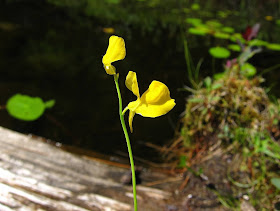The day was fresh and cool and bright when my friends Sue and Ruth and I set out on Lens Lake in western Warren County last week. This is a very quiet Adirondack lake. The few cottages lining the shore are set so far back in the surrounding forest that we cannot see them from the water, and I have rarely ever encountered any other boaters on the water.
One of the features that makes this lovely lake truly remarkable is the presence of extensive bog mats that dot the surface, floating islands carpeted with Sphagnum mosses that create an acidic habitat supportive of many interesting plants. We set off on the mirror-still water to explore this fascinating environment.
As we moved out from shore, we passed through masses of Fragrant Water Lilies dotting the surface.
As we paddled through the lily pads, we appeared to be passing through snow flurries, since the air was filled with tiny white moths that were flitting from pad to pad. Some of the moths were snowy white all over while some were faintly striped with shades of tan and brown. Sue did some research and informed us later that these moths had the most appropriate common name of Polymorphic Pondweed Moth (Parapoynx maculalis). At last, one landed on a lily pad so I could take its photo.
We found so many remarkable plants (as well as some non-plant finds), I am just going to list a selection of them alphabetically, adding a few comments regarding each when appropriate.
ARROW ARUM (Peltandra virginica)
This late in the growing season, the thick flower stalks have produced heavy seed pods and are now bending down to deposit those pods in the surrounding mud.
ARROWHEAD (Sagittata latifolia)
BOG LYCOPODIUM (Lycopodiella inundata)
CADDISFLY EGG CASE
PAWPAW SPHINX MOTH CATERPILLAR (with wasp pupae attached)
COTTONGRASS (Eriophorum species)
CRANBERRY, LARGE (Vaccinium macrocarpon)
HORNED BLADDERWORT (Utricularia cornuta)
HUMMOCK, multicolored, with golden sphagnum, green sedge, and red sundew plants
LABRADOR TEA (Rhododendron groenlandicum), with pink buds holding next year's flowers.
LARGE COMMON BLADDERWORT (Utricularia vulgaris ssp. macrorhiza), underwater structures
MARSH ST. JOHN'S WORT (Hypericum virginicum), with scarlet seedpods
OPHRYDIUM VERSATILE. I could find no common name for this greenish transparent jelly, which we found in shallow water at many places around the lake. It is not a plant nor a fungus nor an animal, but rather a colony of single-cell protozoans that form gelatinous blobs like what you see here, rendered greenish in color by microscopic Chlorella algae that symbiotically inhabit the jelly. It is usually found in acidic waters like that of Lens Lake. Some blobs were as small as baseballs, others as big as a bathtub. This one would have filled a bushel basket.
PITCHER PLANT (Sarracenia purpurea), its scarlet pitchers and flower set off by a mat of golden sphagnum moss
PITCHER PLANT LEAVES, which fill with enzyme-containing water in which insects become trapped and digested to provide nutrients for the plant.
RED SPHAGNUM MOSS (Sphagnum rubellum), a patch with a particularly rich red color
SPHAGNUM MOSSES, mixed red and yellow in color
SPATULATE-LEAVED SUNDEW and PIPEWORT (Drosera intermedia) and (Eriocaulon aquaticum)
SPATULATE-LEAVED SUNDEW, with flower stalks, sprouting from a small piece of floating wood and reflected in the still water.
THREE-WAY SEDGE and PICKERELWEED (Dulichium arundinaceum) and (Pontederia cordata)
WHITE BEAK SEDGE (Rhynchospora alba), a typical species of sphagnum bogs
YELLOW-EYED GRASS (Xyris montana). Although this yellow-flowered wetland plant was no longer in bloom, we could recognize it by its scaled involucres and short, narrow basal leaves. The stems had turned a rather attractive rosy color.


























gorgeous photos
ReplyDeleteVery nice-thank you!
ReplyDeleteI was there three days ago. One of the camp owners was firing off a shotgun while we were there.
ReplyDeleteI'm pleased to say I recognize most of those!
ReplyDeleteVery nice :)
ReplyDeleteBeautiful lake with botanical treasures, even though the species aren't rare in the northeast.
ReplyDelete